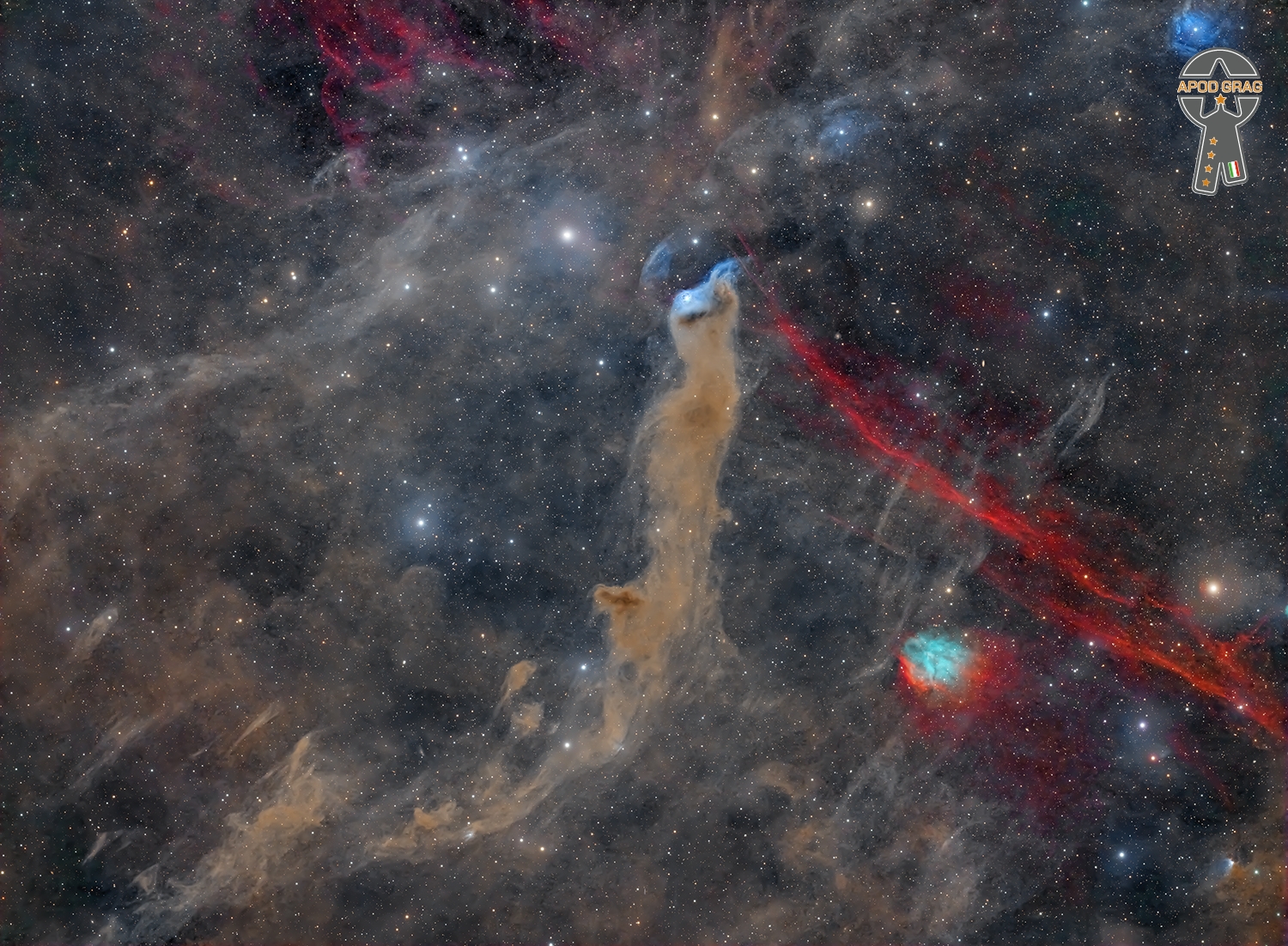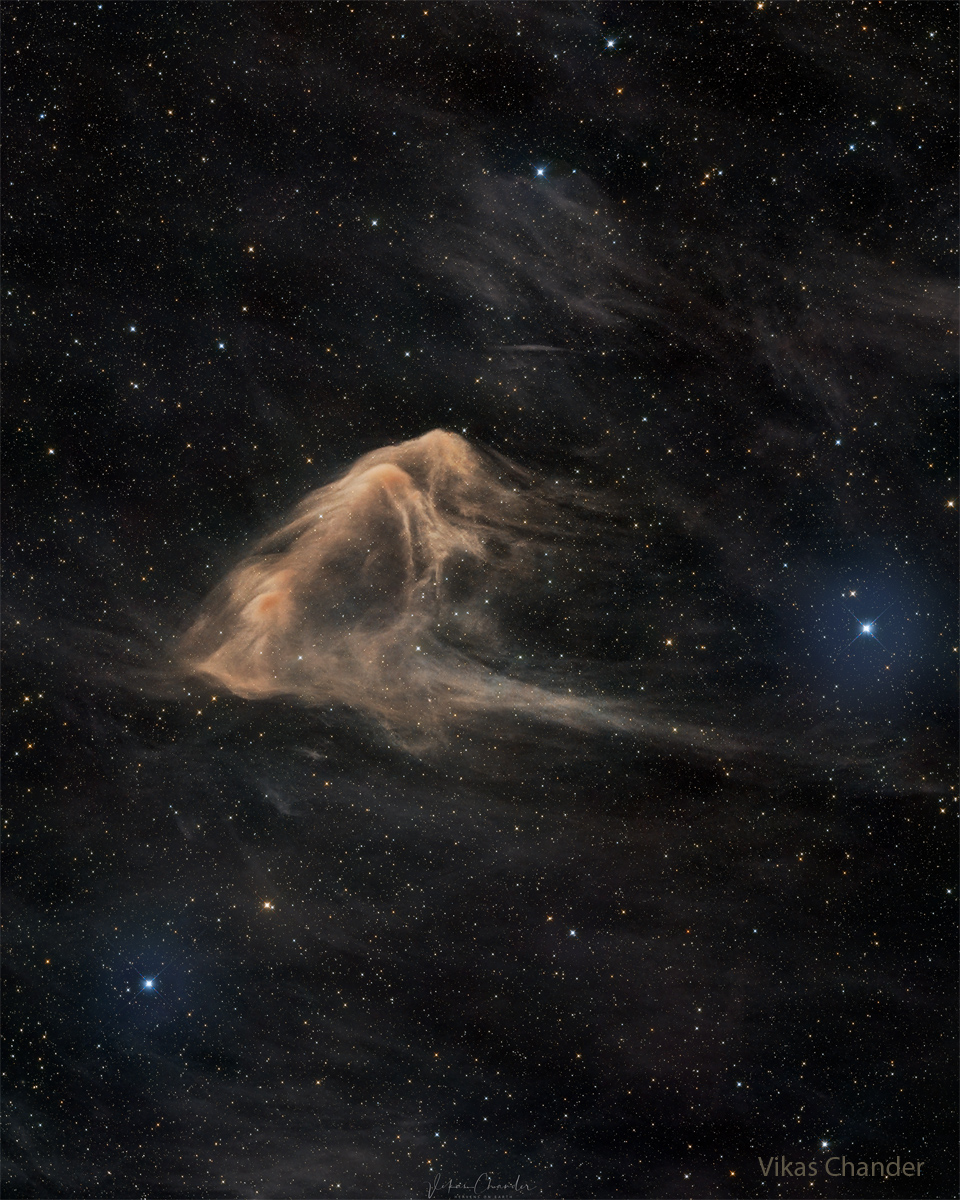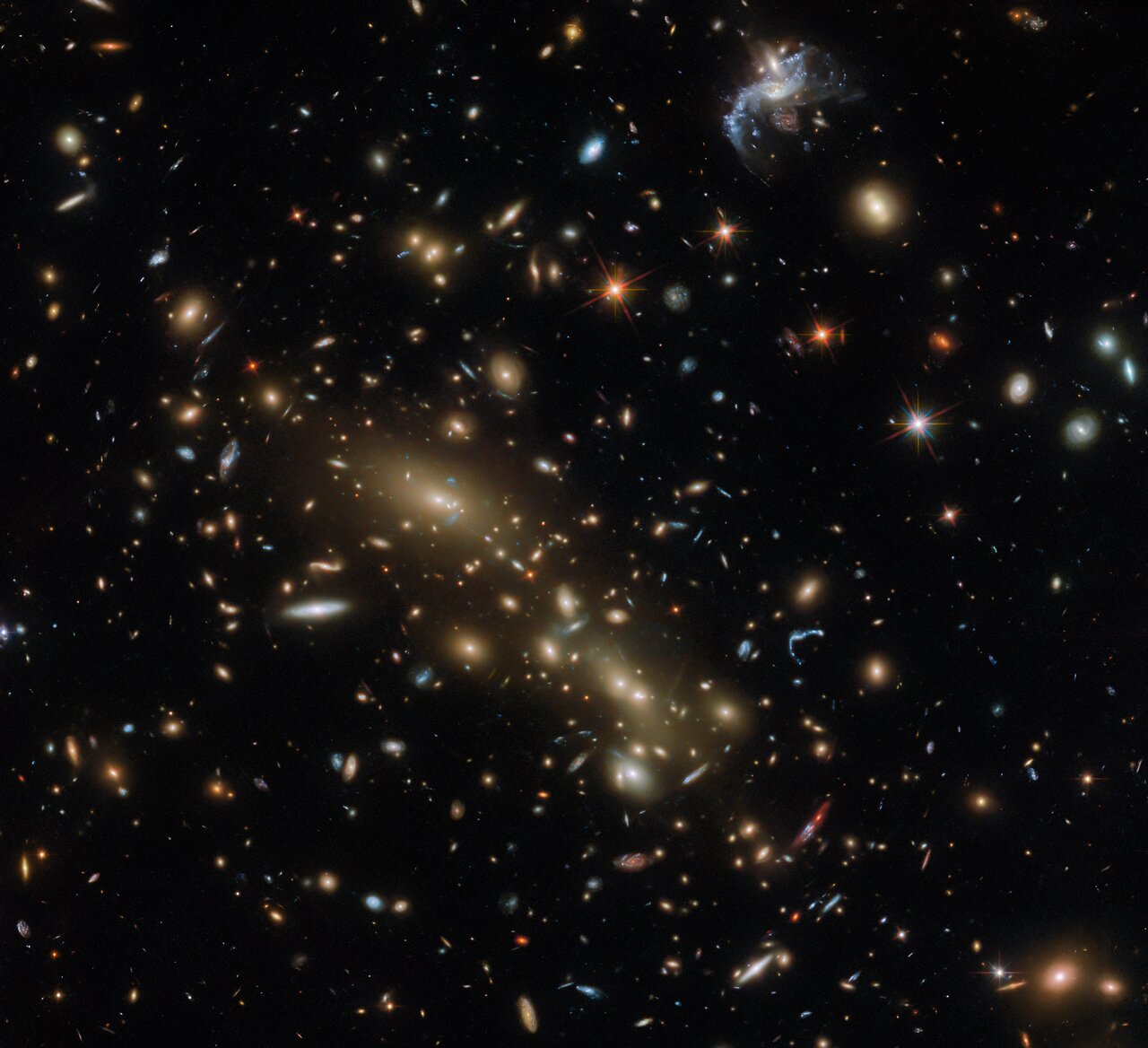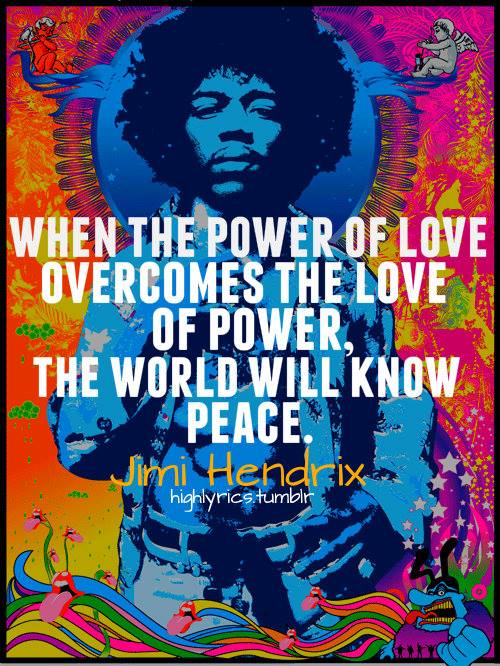The main focus of the shot is, of course, van den Bergh 152 (also catalogued as LBN 531), which is perched on the top (from this point of view–North is down and East is right) of the Barnard 175 Bok globule. Also atop B175 just to the right of vdB 152 is the tiny Herbig-Haro 450, visible as a red splotch. Tycho 4467-434-1, the star that is illuminating vdB 152 was probably not born in the surrounding dust and will eventually drift away from the main structure. But for now, it seems to be kicking up a swirling maelstrom in the dust and gas belonging to B175. More prominently, the wispy supernova remnant G 110.3 +11.3 is visible in Ha coursing through the field from the Northeast toward the Southwest. Nearby is the planetary nebula Dengel-Hartl 5.

Charles Frank Mangione (/ˌmændʒiˈoʊni/ MAN-jee-OH-nee; born November 29, 1940) is an American flugelhorn player, trumpeter and composer. He came to prominence as a member of Art Blakey‘s band in the 1960s, and later co-led the Jazz Brothers with his brother, Gap. He achieved international success in 1978 with his jazz-pop single “Feels So Good“. Mangione has released more than 30 albums since 1960.
Mangione was born and raised in Rochester, New York, United States. With his pianist brother Gap, they led the Mangione Brothers Sextet/Quintet, which recorded three albums for Riverside Records, before Mangione branched out into other work. One of Chuck’s compositions for the Mangione Brothers Sextet, “Something Different,” was recorded by Cannonball Adderley on his 1961 album African Waltz. He attended the Eastman School of Music from 1958 to 1963, then joined Art Blakey‘s Jazz Messengers, for which he filled the trumpet chair previously held by Clifford Brown, Freddie Hubbard, Kenny Dorham, Bill Hardman, and Lee Morgan.
see full post...Billy Hart (born November 29, 1940) is an American jazz drummer and educator. He is known internationally for his work with Herbie Hancock‘s “Mwandishi” band in the early 1970s, as well as with Shirley Horn, Stan Getz, and Quest, among many others.
Hart was born in Washington, D.C. He grew up in close proximity of the Spotlite Club, where he first heard the music of Lee Morgan, Ahmad Jamal, and Miles Davis, among others.
Early on in his career he performed with Otis Redding and Sam and Dave, then with Buck Hill. Although he studied mechanical engineering at Howard University, he left school early to tour with Shirley Horn, whom Hart credits with accelerating his musical development. He was a sideman with the Montgomery Brothers(1961), Jimmy Smith (1964–1966), and Wes Montgomery (1966–68). Following Montgomery’s death in 1968, Hart moved to New York City, where he recorded with McCoy Tyner, Wayne Shorter, Joe Zawinul, and Pharoah Sanders (playing on his famed recording Karma in 1969), in addition to playing with Eddie Harris, Joanne Brackeen, and Marian McPartland.
see full post...John Mayall OBE (born 29 November 1933) is an English blues and rock musician, songwriter and producer. In the 1960s, he formed John Mayall & the Bluesbreakers, a band that has counted among its members some of the most famous blues and blues rock musicians.
Born in Macclesfield, Cheshire, in 1933, Mayall grew up in Cheadle Hulme, Stockport. He was the son of Murray Mayall, a guitarist and jazz enthusiast. From an early age he was drawn to the sounds of American blues players such as Lead Belly, Albert Ammons, Pinetop Smith and Eddie Lang, and taught himself to play the piano, guitars, and harmonica.
Mayall was sent to Korea as part of his national service, and during a period of leave bought his first electric guitar in Japan. Back in England, he enrolled at Manchester College of Art and started playing with a semi-professional band, the Powerhouse Four. After graduation, he obtained a job as an art designer, but continued to play with local musicians. In 1963, he opted for a full-time musical career and moved to London. His previous craft would be put to good use in the designing of covers for many of his coming albums.
see full post...This eagle ray glides across a cosmic sea. Officially cataloged as SH2-63 and LBN 86, the dark nebula is composed of gas and dust that just happens to appear shaped like a common ocean fish. The interstellar dust nebula appears light brown as it blocks and reddens visible light emitted behind it. Dark nebulas glow primarily in infrared light, but also reflect visible light from surrounding stars. The dust in dark nebulas is usually sub-millimeter chunks of carbon, silicon, and oxygen, frequently coated with frozen carbon monoxide and nitrogen. Dark nebulas are also known as molecular clouds because they also contain relatively high amounts of molecular hydrogen and larger molecules. Previously unnamed, the here dubbed Eagle Ray Nebula is normally quite dim but has been imaged clearly over 20-hours through dark skies in Chile.

Randall Stuart Newman (born November 28, 1943 LA, CA) is an American singer-songwriter, arranger, composer, and pianist known for his Southern-accented singing style, early Americana-influenced songs (often with mordant or satirical lyrics), and various film scores. His hits as a recording artist include “Short People” (1977), “I Love L.A.” (1983), and “You’ve Got a Friend in Me” (1995) with Lyle Lovett, while other artists have enjoyed success with cover versions of his “Mama Told Me Not to Come” (1966), “I Think It’s Going to Rain Today” (1968) and “You Can Leave Your Hat On” (1972).
Born in Los Angeles to an extended family of Hollywood film composers, Newman began his songwriting career at the age of 17, penning hits for acts such as the Fleetwoods, Cilla Black, Gene Pitney, and the Alan Price Set. In 1968, he made his formal debut as a solo artist with the album Randy Newman, produced by Lenny Waronker and Van Dyke Parks. Four of Newman’s non-soundtrack albums have charted in the US top 40: Sail Away (1972), Good Old Boys (1974), Little Criminals (1977), and Harps and Angels (2008).
Since the 1980s, Newman has worked mostly as a film composer. He has scored nine Disney–Pixaranimated films, including all four Toy Story films (1995–2019), A Bug’s Life (1998), both Monsters, Inc. films (2001, 2013), and the first and third Cars films (2006, 2017), as well as Disney’s James and the Giant Peach(1996) and The Princess and the Frog (2009). His other film scores include Cold Turkey (1971), Ragtime(1981), The Natural (1984), Awakenings (1990), Cats Don’t Dance (1997), Pleasantville (1998), Meet the Parents (2000), Seabiscuit (2003), and Marriage Story (2019).
Newman has received twenty-two Academy Award nominations in the Best Original Score and Best Original Song categories and has won twice in the latter category, contributing to the Newmans being the most nominated Academy Award extended family, with a collective 92 nominations in various music categories. He has also won three Emmys, seven Grammy Awards and the Governor’s Award from the Recording Academy. In 2007, he was recognized by the Walt Disney Company as a Disney Legend. He was inducted into the Songwriters Hall of Fame in 2002 and to the Rock and Roll Hall of Fame in 2013.
see full post...Leandro “Gato” Barbieri (November 28, 1932 – April 2, 2016) was an Argentine jazz tenor saxophonist who rose to fame during the free jazz movement in the 1960s and is known for his Latin jazz recordings of the 1970s. His nickname, Gato, is Spanish for “cat”.
Born to a family of musicians, Barbieri began playing music after hearing Charlie Parker‘s “Now’s the Time”. He played the clarinet and later the alto saxophone while performing with Argentine pianist Lalo Schifrin in the late 1950s. By the early 1960s, while playing in Rome, he also worked with the trumpeter Don Cherry. By now influenced by John Coltrane‘s late recordings, as well as those from other free jazz saxophonists such as Albert Ayler and Pharoah Sanders, he began to develop the warm and gritty tone with which he is associated. In the late 1960s, he was fusing music from South America into his playing and contributed to multi-artist projects like Charlie Haden‘s Liberation Music Orchestra and Carla Bley‘s Escalator over the Hill. His score for Bernardo Bertolucci‘s 1972 film Last Tango in Paris earned him a Grammy Award and led to a record deal with Impulse! Records.
https://www.youtube.com/watch?v=j1VGfyiLsDM
see full post...Gigi Gryce (born George General Grice Jr.; November 28, 1925 – March 14, 1983), later Basheer Qusim, was an American jazz saxophonist, flautist, clarinetist, composer, arranger, and educator.
While his performing career was relatively short, much of his work as a player, composer, and arranger was quite influential and well-recognized during his time. However, Gryce abruptly ended his jazz career in the 1960s. This, in addition to his nature as a very private person, has resulted in very little knowledge of Gryce today. Several of his compositions have been covered extensively (“Minority“, “Social Call”, “Nica’s Tempo”) and have become minor jazz standards. Gryce’s compositional bent includes harmonic choices similar to those of contemporaries Benny Golson, Tadd Dameron and Horace Silver. Gryce’s playing, arranging, and composing are most associated with the classic hard bop era (roughly 1953–1965). He was a well-educated composer and musician, and wrote some classical works as a student at the Boston Conservatory. As a jazz musician and composer he was very much influenced by the work of Charlie Parker and Thelonious Monk. George General Gryce Jr. was born in Pensacola, Florida on November 28, 1925. Gryce died on March 14, 1983, of a heart attack after becoming increasingly ill. Before his death he reached out to his family again, and visited Pensacola for the first time in almost thirty years.
see full post...This Hubble Picture of the Week features a massive cluster of brightly glowing galaxies, first identified as Abell 3192. Like all galaxy clusters, this one is suffused with hot gas that emits powerful X-rays, and it is enveloped in a halo of invisible dark matter. All this unseen material — not to mention the many galaxies visible in this image — comprises such a huge amount of mass that the galaxy cluster noticeably curves spacetime around it, making it into a gravitational lens. Smaller galaxies behind the cluster appear distorted into long, warped arcs around the cluster’s edges.
The galaxy cluster is located in the constellation Eridanus, but the question of its distance from Earth is a more complicated one. Abell 3192 was originally documented in the 1989 update of the Abell catalogue, a catalogue of galaxy clusters that was first published in 1958. At that time, Abell 3192 was thought to comprise a single cluster of galaxies, concentrated at a single distance. However, further research revealed something surprising: the cluster’s mass seemed to be densest at two distinct points rather than one.
It was subsequently shown that the original Abell cluster actually comprised two independent galaxy clusters — a foreground group around 2.3 billion light-years from Earth, and a further group at the greater distance of about 5.4 billion light-years from our planet. The more distant galaxy cluster, included in the Massive Cluster Survey as MCS J0358.8-2955, is central in this image. The two galaxy groups are thought to have masses equivalent to around 30 trillion and 120 trillion times the mass of the Sun, respectively. Both of the two largest galaxies at the centre of this image are part of MCS J0358.8-2955; the smaller galaxies you see here, however, are a mixture of the two groups within Abell 3192.
[Image Description: A cluster of galaxies, concentrated around what appear to be two large elliptical galaxies. The rest of the black background is covered in smaller galaxies of all shapes and sizes. In the top left and bottom right, beside the two large galaxies, some galaxies appear notably distorted into curves by gravity.]

Lyle David Mays (November 27, 1953 – February 10, 2020) was an American jazz pianist, composer, and member of the Pat Metheny Group. Metheny and Mays composed and arranged nearly all of the group’s music, for which Mays won eleven Grammy Awards.
While growing up in rural Wisconsin, Mays had a lot of curiosity but had to learn many things all by himself due to a lack of available resources and information. He had four main interests: chess, mathematics, architecture, and music. His mother Doris played piano and organ, and his father Cecil, a truck driver, taught himself to play guitar by ear. His teacher allowed him to practice improvisation after the structured elements of the lesson were completed. At the age of nine, he played the organ at a family member’s wedding, and fourteen he began to play in church. During his senior year of high school, at summer national stage band camp in Normal, Illinois, he was introduced to jazz pianist Marian McPartland.
Bill Evans at the Montreux Jazz Festival and Filles de Kilimanjaro by Miles Davis (both recorded in 1968) were important influences. He attended the University of North Texas after transferring from the University of Wisconsin–Eau Claire. He composed and arranged for the One O’Clock Lab Band and was the composer and arranger for the Grammy Award-nominated album Lab 75.
see full post...
Randal Edward Brecker (born November 27, 1945) is an American trumpeter, flugelhornist, and composer. His versatility has made him a popular studio musician who has recorded with acts in jazz, rock, and R&B.
Brecker was born on November 27, 1945, in the Philadelphia suburb of Cheltenham to a musical family. His father Bob (Bobby) was a lawyer who played jazz piano, and his mother Sylvia was a portrait artist.
Randy described his father as “a semipro jazz pianist and trumpet fanatic. In school when I was eight, they only offered trumpet or clarinet. I chose trumpet from hearing Diz, Miles, Clifford, and Chet Baker at home. My brother (Michael Brecker) didn’t want to play the same instrument as I did, so three years later he chose the clarinet!”
Randy’s father, Bob, was also a songwriter and singer who loved to listen to recordings of the great jazz trumpet players such as Miles Davis, Dizzy Gillespie and Clifford Brown. He took Randy and his younger brother Michael Brecker to see Davis, Thelonious Monk, Duke Ellington, and many other jazz icons.
Brecker attended Cheltenham High School from 1959 to 1963 and then Indiana University from 1963 to 1966 studying with Bill Adam, David Baker and Jerry Coker and later moved to New York and performed with Clark Terry‘s Big Bad Band, the Duke Pearson and the Thad Jones/Mel Lewis Orchestra.
see full post...Edward Otha South (November 27, 1904 – April 25, 1962) was an American jazz violinist.
South studied classical music in Budapest, Paris, and Chicago. He turned to jazz because, as a Black musician, there was no room for him in classical music. In the 1920s he was a member of jazz orchestras led by Charlie Elgar, Erskine Tate, and Jimmy Wade. From 1928 to 1930, he was touring in Europe with his band, Eddie South’s Alabamians, with whom he had already made several records. He recorded during this tour as well. During this tour, the Alabamians had an extended stay in Venice, in 1928, at the Luna Hotel.
He led a band in the early 1930s that included Milt Hinton and Everett Barksdale. In 1937 he recorded in Paris with Stephane Grappelli, Django Reinhardt, and Michel Warlop. In 1945 he worked for the studio band at WMGM in New York City. During the 1950s, he was a guest on television with Fran Allison and Dave Garroway and on WGN in Chicago.
On September 2, 2020, The New York Times consulted violinist Mazz Swift, who selected Eddie South’s performance of “Black Gypsy” for a feature on “5 Minutes That Will Make You Love the Violin.
see full post...James Marshall “Jimi” Hendrix (born Johnny Allen Hendrix; November 27, 1942 – September 18, 1970 Seattle, WA) was an American guitarist, songwriter and singer. Although his mainstream career spanned only four years, he is widely regarded as one of the greatest and most influential electric guitarists in the history of popular music, and one of the most celebrated musicians of the 20th century. The Rock and Roll Hall of Famedescribes him as “arguably the greatest instrumentalist in the history of rock music.
Born in Seattle, Washington, Hendrix began playing guitar at age 15. In 1961, he enlisted in the US Army, but was discharged the following year. Soon afterward, he moved to Clarksville then Nashville, Tennessee, and began playing gigs on the chitlin’ circuit, earning a place in the Isley Brothers‘ backing band and later with Little Richard, with whom he continued to work through mid-1965. He then played with Curtis Knight and the Squires before moving to England in late 1966 after bassist Chas Chandler of the Animals became his manager. Within months, Hendrix had earned three UK top ten hits with the Jimi Hendrix Experience: “Hey Joe“, “Purple Haze“, and “The Wind Cries Mary“. He achieved fame in the US after his performance at the Monterey Pop Festival in 1967, and in 1968 his third and final studio album, Electric Ladyland, reached number one in the US. The double LP was Hendrix’s most commercially successful release and his first and only number one album. The world’s highest-paid performer, he headlined the Woodstock Festival in 1969 and the Isle of Wight Festival in 1970 before his accidental death in London from barbiturate-related asphyxiain September 1970.
Hendrix was inspired by American rock and roll and electric blues. He favored overdriven amplifiers with high volume and gain, and was instrumental in popularizing the previously undesirable sounds caused by guitar amplifier feedback. He was also one of the first guitarists to make extensive use of tone-altering effects unitsin mainstream rock, such as fuzz distortion, Octavia, wah-wah, and Uni-Vibe. He was the first musician to use stereophonic phasing effects in recordings. Holly George-Warren of Rolling Stone commented: “Hendrix pioneered the use of the instrument as an electronic sound source. Players before him had experimented with feedback and distortion, but Hendrix turned those effects and others into a controlled, fluid vocabulary every bit as personal as the blues with which he began.”
Hendrix was the recipient of several music awards during his lifetime and posthumously. In 1967, readers of Melody Maker voted him the Pop Musician of the Year and in 1968, Billboard named him the Artist of the Year and Rolling Stone declared him the Performer of the Year. Disc and Music Echo honored him with the World Top Musician of 1969 and in 1970, Guitar Player named him the Rock Guitarist of the Year. The Jimi Hendrix Experience was inducted into the Rock and Roll Hall of Fame in 1992 and the UK Music Hall of Fame in 2005. Rolling Stone ranked the band’s three studio albums, Are You Experienced (1967), Axis: Bold as Love (1967), and Electric Ladyland (1968), among the “500 Greatest Albums of All Time“, and they ranked Hendrix as the greatest guitarist and the sixth-greatest artist of all time. Hendrix was named the greatest guitarist of all time by Rolling Stone in 2023.
see full post...